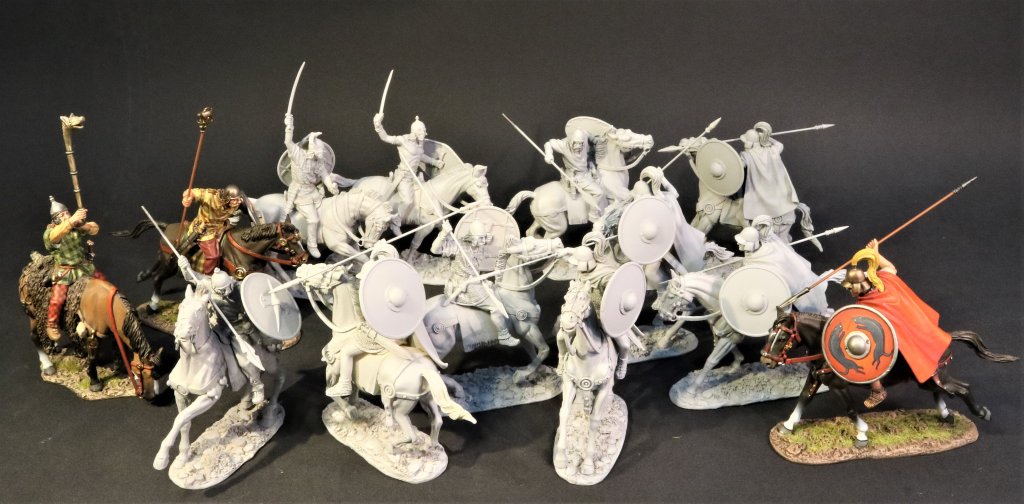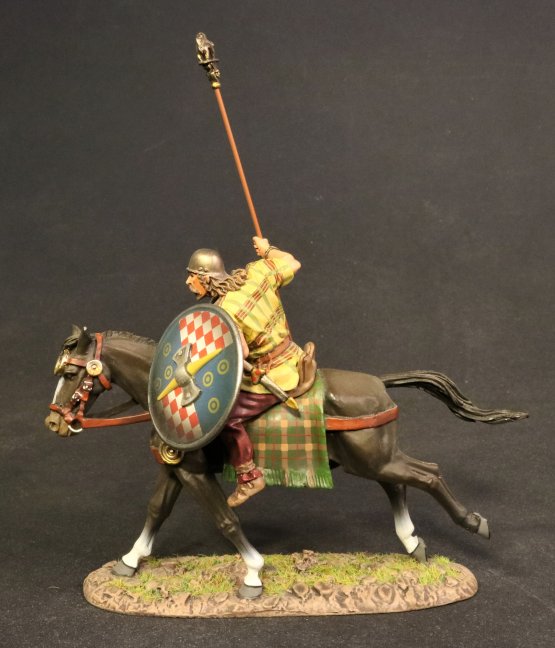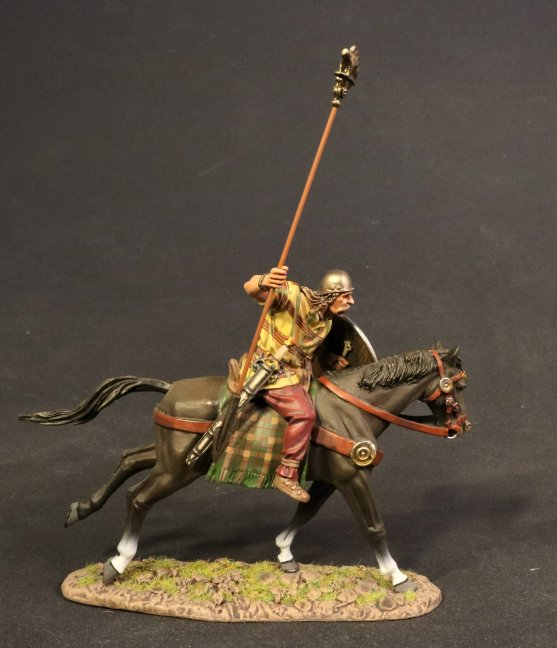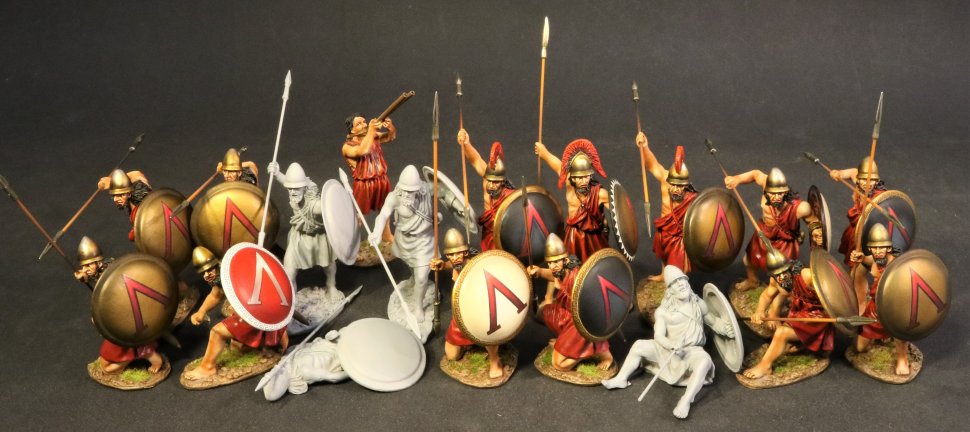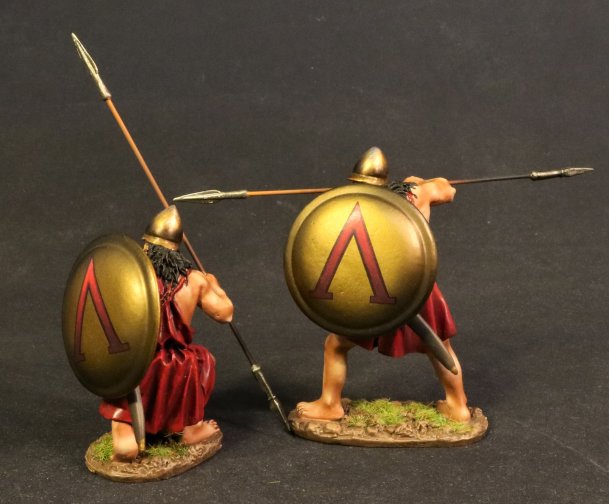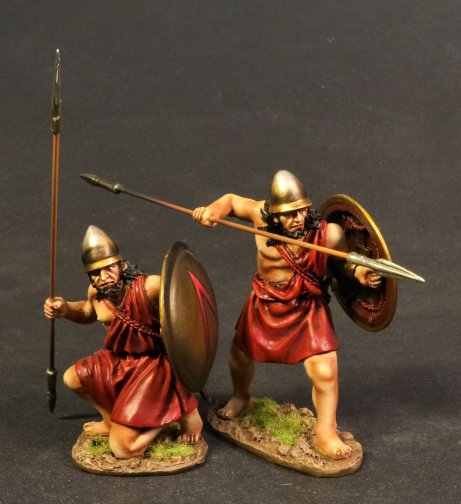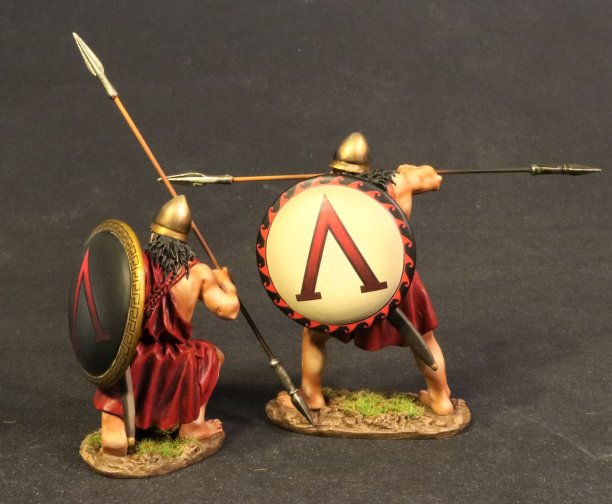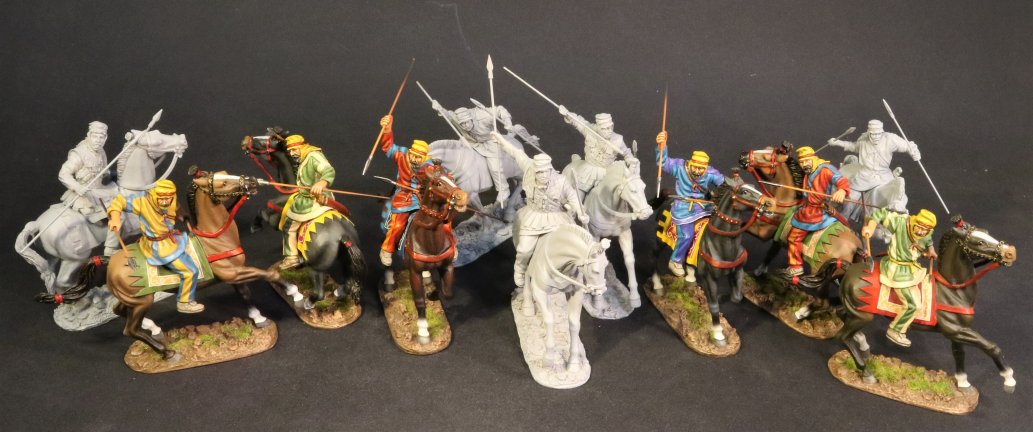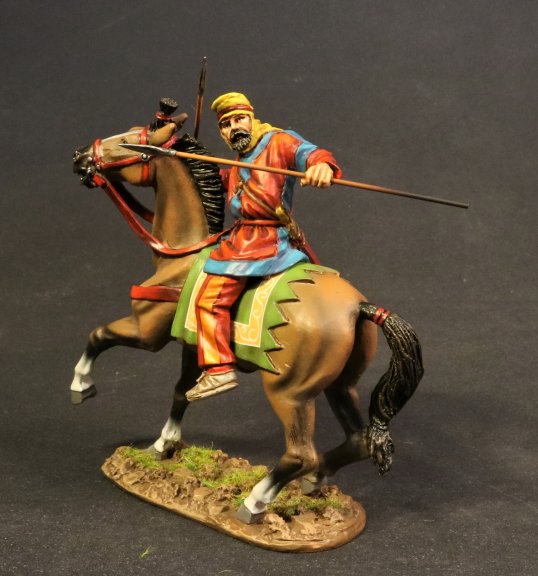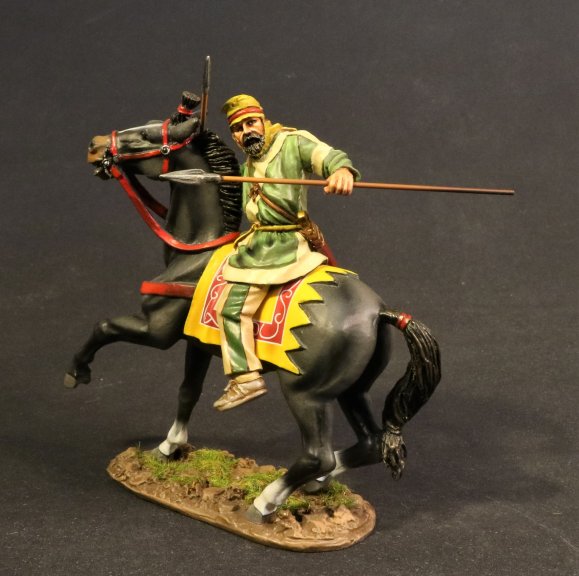NEW RELEASES FOR JANUARY 2020
THE ANCIENTS COLLECTION
ARMIES AND ENEMIES OF ANCIENT ROME
REPUBLICAN ROMANS
The Roman Republic was the era of classical Roman civilization beginning with the overthrow of the Roman Kingdom, traditionally dated to 509 BC, and ending in 27 BC with the establishment of the Roman Empire. It was during this period that Rome's control expanded from the city's immediate surroundings to hegemony over the entire Mediterranean world.
Roman government was headed by two consuls, elected annually by the citizens and advised by a senate composed of appointed magistrates. As Roman society was very hierarchical by modern standards, the evolution of the Roman government was heavily influenced by the struggle between the patricians, Rome's land-holding aristocracy, who traced their ancestry to the founding of Rome, and the plebeians, the far more numerous citizen-commoners. Over time, the laws that gave patricians exclusive rights to Rome's highest offices were repealed or weakened, and leading plebeian families became full members of the aristocracy. The leaders of the Republic developed a strong tradition and morality requiring public service and patronage in peace and war, making military and political success inextricably linked. Many of Rome's legal and legislative structures (later codified into the Justinian Code, and again into the Napoleonic Code) can still be observed throughout Europe and much of the world in modern nation states and international organizations.
During the first two centuries of its existence, the Roman Republic expanded through a combination of conquest and alliance, from central Italy to the entire Italian peninsula. By the following century, it included North Africa, most of the Iberian Peninsula, and what is now southern France. Two centuries after that, towards the end of the 1st century BC, it included the rest of modern France, Greece, and much of the eastern Mediterranean. By this time, internal tensions led to a series of civil wars, culminating with the assassination of Julius Caesar, which led to the transition from republic to empire.
Historians have variously proposed Julius Caesar's crossing of the Rubicon River in 49 BC, Caesar's appointment as dictator for life in 44 BC, and the defeat of Mark Antony and Cleopatra at the Battle of Actium in 31 BC. However, most use the same date as did the ancient Romans themselves, the Roman Senate's grant of extraordinary powers to Octavian and his adopting the title Augustus in 27 BC, as the defining event ending the Republic.
THE ROMAN ARMY OF THE MID REPUBLIC 275 – 140BC
The Roman army of the mid-Republic (also known as the manipular Roman army or the "Polybian army"), refers to the armed forces deployed by the mid-Roman Republic, from the end of the Samnite Wars (290 BC) to the end of the Social War (88 BC). The first phase of this army, in its manipular structure (290–ca. 130 BC), is described in detail in the Histories of the ancient Greek historian Polybius, writing before 146 BC.
The central feature of the mid-Republican army was the manipular organisation of its battle-line. Instead of a single, large mass (the phalanx) as in the Greek and Early Roman army, the Romans now drew up in three lines (triplex acies) consisting of small units (maniples) of 120 men, arrayed in chessboard fashion, giving much greater tactical strength and flexibility.
The Republican army of this period, like its earlier forebear, did not maintain standing or professional military forces, but levied them, by compulsory conscription, as required for each campaigning season and disbanded thereafter (although formations could be kept in being over winter during major wars). Service in the legions was limited to property-owning Roman citizens, normally those known as iuniores (age 16-46).
For the vast majority of the period of its existence, the Polybian levy was at war. This led to great strains on Roman and Italian manpower, but forged a superb fighting machine. During the Second Punic War, fully two-thirds of Roman iuniores were under arms continuously. In the period after the defeat of Carthage in 201 BC, the army was campaigning exclusively outside Italy, resulting in its men being away from their home plots of land for many years at a stretch. They were assuaged by the large amounts of booty that they shared after victories in the rich eastern theatre. But in Italy, the ever-increasing concentration of public lands in the hands of big landowners, and the consequent displacement of the soldiers' families, led to great unrest and demands for land redistribution. This was successfully achieved, but resulted in the disaffection of Rome's Italian allies, who as non-citizens were excluded from the redistribution. This led to the mass revolt of the socii and the Social War (91-88 BC). The result was the grant of Roman citizenship to all Italians and the end of the Polybian army's dual structure: the alae were abolished and the socii recruited into the legions. The Roman army of the late Republic (88–30 BC) resulted, a transitional phase to the Imperial Roman army (30 BC – AD 284).
THE VELITES
Velites were the youngest and usually the poorest (being fifth class citizens, with property worth 400–2,500 denarii) soldiers in the legion, and could rarely afford much equipment. They were armed with veretum, light javelins, each with a 90 cm (3 ft) wooden shaft the diameter of a finger, with a c. 10-inch (25 cm) narrow metal point, and tips designed to bend on impact to prevent them being thrown back, similar to the heavier pila of other legionaries. Livy says that they each carried seven javelins, however Roman satirist Lucilius says that they carried five, suggesting that the amount may have changed. The hastati and principes carried gladii, relatively short thrusting swords 74 centimetres (29 inches) in length, as their main weapons, and the velites carried them as backup weapons. They fought in a very loose, staggered formation like most irregular troops, and carried small round shields called parma, 90 cm (3 feet) in diameter.
The velites were placed at the front of the maniples, so that the velites had the chance to prove themselves and win glory by seeking out single combat with an enemy. This is also why they wore highly identifiable wolfskin headdresses
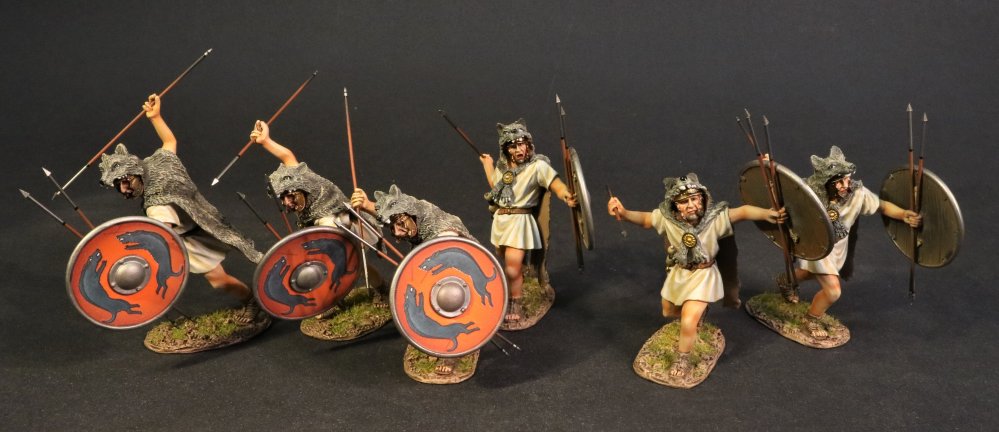
The velites were placed at the front of the maniples, so that the velites had the chance to prove themselves and win glory by seeking out single combat with an enemy. This is also why they wore highly identifiable wolfskin headdresses.
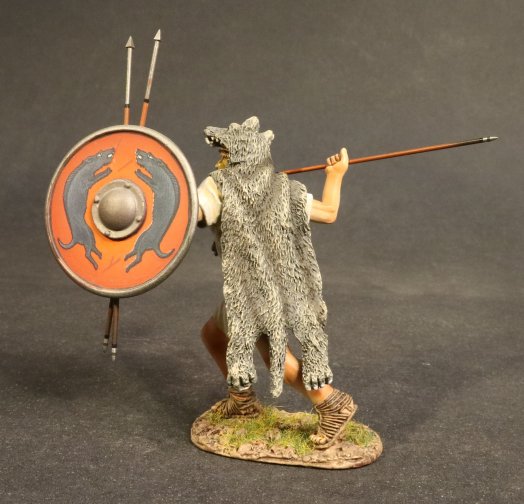
VMRR-02R
ARMIES AND ENEMIES OF ANCIENT ROME,
THE ROMAN ARMY OF THE MID REPUBLIC,
VELES.
(2pcs)
In the legion, the velites were attached to each maniple of hastati, principes and triarii. They usually formed up at the front of the legion before battle to harass the enemy with javelin throws and to prevent the enemy doing the same before retiring behind the lines to allow the heavier infantry to attack. After they had fallen back, they would move up behind the attacking troops and throw darts at the enemy. They also sometimes carried wounded back to the rear, however usually a corps of deportates did this. In a pitched battle, the velites would form up at the front of the legion and cover the advance of the hastati, who were armed with swords.
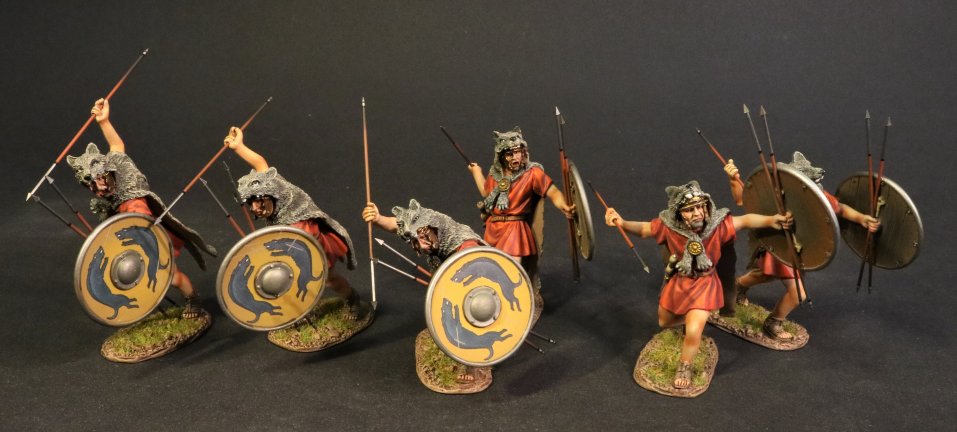
In the standard legion around the time of the Second Punic War (218 -201 BC) there were 10 maniples of hastati, each having 120 hastati, with 40 velites attached.
The maniples were further split into centuries, of 60 hastati and 20 velites, with the centurion of the hastati century commanding the velites as well
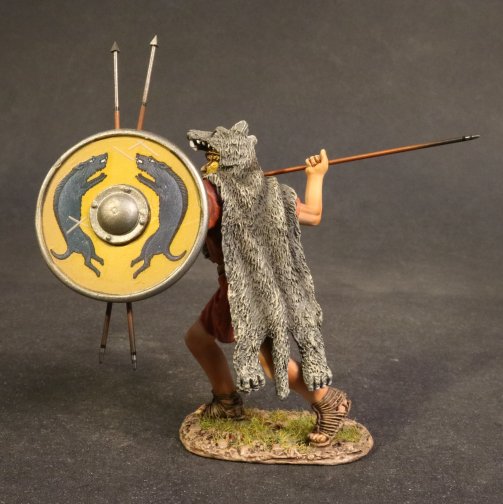
VMRR-02Y
ARMIES AND ENEMIES OF ANCIENT ROME,
THE ROMAN ARMY OF THE MID REPUBLIC,
VELES.
(2 pcs)
When the Romans set up a temporary castra, two maniples (without their velites) were selected to pitch the tents of the headquarters and officers, and details were made for fatigue duty, to get wood and water, and to give food and water to the animals accompanying them. The rest of the men, excepting velites and officers, set up the tents of the soldiers. During this time the velites would guard the outside of the wall and the wall itself, while the rest of the troops would guard the interior. The watch, which was composed of eight men led by a decurion, ran from 6:00 am to 6:00 pm, and was divided into four shifts, each of three hours.
THE ANCIENTS COLLECTION
ARMIES AND ENEMIES OF ANCIENT ROME
REPUBLICAN ROMANS
The Roman Republic was the era of classical Roman civilization beginning with the overthrow of the Roman Kingdom, traditionally dated to 509 BC, and ending in 27 BC with the establishment of the Roman Empire. It was during this period that Rome's control expanded from the city's immediate surroundings to hegemony over the entire Mediterranean world.
Roman government was headed by two consuls, elected annually by the citizens and advised by a senate composed of appointed magistrates. As Roman society was very hierarchical by modern standards, the evolution of the Roman government was heavily influenced by the struggle between the patricians, Rome's land-holding aristocracy, who traced their ancestry to the founding of Rome, and the plebeians, the far more numerous citizen-commoners. Over time, the laws that gave patricians exclusive rights to Rome's highest offices were repealed or weakened, and leading plebeian families became full members of the aristocracy. The leaders of the Republic developed a strong tradition and morality requiring public service and patronage in peace and war, making military and political success inextricably linked. Many of Rome's legal and legislative structures (later codified into the Justinian Code, and again into the Napoleonic Code) can still be observed throughout Europe and much of the world in modern nation states and international organizations.
During the first two centuries of its existence, the Roman Republic expanded through a combination of conquest and alliance, from central Italy to the entire Italian peninsula. By the following century, it included North Africa, most of the Iberian Peninsula, and what is now southern France. Two centuries after that, towards the end of the 1st century BC, it included the rest of modern France, Greece, and much of the eastern Mediterranean. By this time, internal tensions led to a series of civil wars, culminating with the assassination of Julius Caesar, which led to the transition from republic to empire.
Historians have variously proposed Julius Caesar's crossing of the Rubicon River in 49 BC, Caesar's appointment as dictator for life in 44 BC, and the defeat of Mark Antony and Cleopatra at the Battle of Actium in 31 BC. However, most use the same date as did the ancient Romans themselves, the Roman Senate's grant of extraordinary powers to Octavian and his adopting the title Augustus in 27 BC, as the defining event ending the Republic.
THE ROMAN ARMY OF THE MID REPUBLIC 275 – 140BC
The Roman army of the mid-Republic (also known as the manipular Roman army or the "Polybian army"), refers to the armed forces deployed by the mid-Roman Republic, from the end of the Samnite Wars (290 BC) to the end of the Social War (88 BC). The first phase of this army, in its manipular structure (290–ca. 130 BC), is described in detail in the Histories of the ancient Greek historian Polybius, writing before 146 BC.
The central feature of the mid-Republican army was the manipular organisation of its battle-line. Instead of a single, large mass (the phalanx) as in the Greek and Early Roman army, the Romans now drew up in three lines (triplex acies) consisting of small units (maniples) of 120 men, arrayed in chessboard fashion, giving much greater tactical strength and flexibility.
The Republican army of this period, like its earlier forebear, did not maintain standing or professional military forces, but levied them, by compulsory conscription, as required for each campaigning season and disbanded thereafter (although formations could be kept in being over winter during major wars). Service in the legions was limited to property-owning Roman citizens, normally those known as iuniores (age 16-46).
For the vast majority of the period of its existence, the Polybian levy was at war. This led to great strains on Roman and Italian manpower, but forged a superb fighting machine. During the Second Punic War, fully two-thirds of Roman iuniores were under arms continuously. In the period after the defeat of Carthage in 201 BC, the army was campaigning exclusively outside Italy, resulting in its men being away from their home plots of land for many years at a stretch. They were assuaged by the large amounts of booty that they shared after victories in the rich eastern theatre. But in Italy, the ever-increasing concentration of public lands in the hands of big landowners, and the consequent displacement of the soldiers' families, led to great unrest and demands for land redistribution. This was successfully achieved, but resulted in the disaffection of Rome's Italian allies, who as non-citizens were excluded from the redistribution. This led to the mass revolt of the socii and the Social War (91-88 BC). The result was the grant of Roman citizenship to all Italians and the end of the Polybian army's dual structure: the alae were abolished and the socii recruited into the legions. The Roman army of the late Republic (88–30 BC) resulted, a transitional phase to the Imperial Roman army (30 BC – AD 284).
THE VELITES
Velites were the youngest and usually the poorest (being fifth class citizens, with property worth 400–2,500 denarii) soldiers in the legion, and could rarely afford much equipment. They were armed with veretum, light javelins, each with a 90 cm (3 ft) wooden shaft the diameter of a finger, with a c. 10-inch (25 cm) narrow metal point, and tips designed to bend on impact to prevent them being thrown back, similar to the heavier pila of other legionaries. Livy says that they each carried seven javelins, however Roman satirist Lucilius says that they carried five, suggesting that the amount may have changed. The hastati and principes carried gladii, relatively short thrusting swords 74 centimetres (29 inches) in length, as their main weapons, and the velites carried them as backup weapons. They fought in a very loose, staggered formation like most irregular troops, and carried small round shields called parma, 90 cm (3 feet) in diameter.
The velites were placed at the front of the maniples, so that the velites had the chance to prove themselves and win glory by seeking out single combat with an enemy. This is also why they wore highly identifiable wolfskin headdresses

The velites were placed at the front of the maniples, so that the velites had the chance to prove themselves and win glory by seeking out single combat with an enemy. This is also why they wore highly identifiable wolfskin headdresses.

VMRR-02R
ARMIES AND ENEMIES OF ANCIENT ROME,
THE ROMAN ARMY OF THE MID REPUBLIC,
VELES.
(2pcs)
In the legion, the velites were attached to each maniple of hastati, principes and triarii. They usually formed up at the front of the legion before battle to harass the enemy with javelin throws and to prevent the enemy doing the same before retiring behind the lines to allow the heavier infantry to attack. After they had fallen back, they would move up behind the attacking troops and throw darts at the enemy. They also sometimes carried wounded back to the rear, however usually a corps of deportates did this. In a pitched battle, the velites would form up at the front of the legion and cover the advance of the hastati, who were armed with swords.

In the standard legion around the time of the Second Punic War (218 -201 BC) there were 10 maniples of hastati, each having 120 hastati, with 40 velites attached.
The maniples were further split into centuries, of 60 hastati and 20 velites, with the centurion of the hastati century commanding the velites as well

VMRR-02Y
ARMIES AND ENEMIES OF ANCIENT ROME,
THE ROMAN ARMY OF THE MID REPUBLIC,
VELES.
(2 pcs)
When the Romans set up a temporary castra, two maniples (without their velites) were selected to pitch the tents of the headquarters and officers, and details were made for fatigue duty, to get wood and water, and to give food and water to the animals accompanying them. The rest of the men, excepting velites and officers, set up the tents of the soldiers. During this time the velites would guard the outside of the wall and the wall itself, while the rest of the troops would guard the interior. The watch, which was composed of eight men led by a decurion, ran from 6:00 am to 6:00 pm, and was divided into four shifts, each of three hours.


